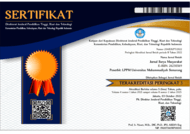Pencegahan Penyakit Demam Berdarah Dengue (DBD) dengan Pembuatan Bio Spray Pengusir Nyamuk di Kelurahan Taman Sari, Ampenan, NTB
(1) Sekolah Tinggi Ilmu Kesehatan Nasional, Surakarta, Indonesia
(2) Sekolah Tinggi Ilmu Kesehatan Nasional, Surakarta, Indonesia
(*) Corresponding Author
Abstract
Dengue hemorrhagic fever (DHF) in West Nusa Tenggara in 2017 has an incidence rate per 100,000 population of 26.86 above the national rate of 22.55% and a Case Fatality Rate of 0.15%. Prevention of mosquitoes with insecticides is the main choice for people to avoid mosquito bites. Insecticide products circulating in the community include combustion, electricity, spray, burn, and lotion. The chemicals contained in mosquito repellent insecticides include organochlorines, organophosphates, carbamates, pyrethroids, and DEET. The synthetic active ingredients pose a threat to human health. This underlies the implementation of Community Service Program from Undergraduate Programm in Pharmacy STIKES Nasional for the development of safer insecticide products use natural potentials such as lemongrass, cloves, and lime leaves. The method used is to provide education about dengue disease, the Aedes Aegypti mosquito, and a workshop by making bio spray. The results show that there is an increase in the knowledge of the people of Taman Sari, Ampenan, West Nusa Tenggara about the efforts to prevent DHF, as indicated by an increase in all correct post-test answers, In addition, the results of evaluations of overall community service satisfaction programs are very interesting.
Keywords
Full Text:
PDFReferences
Bermawie, Nurliani. (2006). Mengatasi Demam Berdarah dengan Tanaman Obat. Jurnal Warta Penelitian Dan Pengembangan Pertanian, 28(6), 6–8.
Dinkes NTB. (2019). Profil Kesehatan NTB 2018 (Vol. 53). Retrieved from https://doi.org/10.1017/CBO9781107415324.004
Hidayat, Meilinah, Rosnaeni, dan Katrin Fitria Hendranata. 2010. Efek repelen minyak lavender, minyak mawar dan minyak rosemari terhadap nyamuk Aedes aegypti. Jurnal Medika Planta. 1(1): 67-74.
Kementerian Kesehatan RI. (2018). Situasi Penyakit Demam Berdarah Di Indonesia 2017 (Vol. 31). Retrieved from https://doi.org/10.3376/1081-1710(2006)31[71:aomtva]2.0.co;2
Mulyani, S., Mulyaningsih, B., Lestari, A. W., M, F. A., & S, D. S. A. (2013). Lemongrass, Cloves, Orange leaves as Insence Combustible for Aedes Aegypti Repellant. Traditional Medicine Journal, 18(September), 195–200.
Nuriyah, N. (2011). Aplikasi Minyak Daun Cengkih dan Minyak Serai Wangi sebagai Bahan Aktif Antiserangga Alami. Srkripsi. Retrieved from https://repository.ipb.ac.id/jspui/bitstream/123456789/52090/1/F11nnu.pdf
Article Metrics
Abstract view : 2903 timesPDF - 1060 times
DOI: https://doi.org/10.26714/jsm.3.1.2020.55-61
Refbacks
- There are currently no refbacks.
Copyright (c) 2020 Jurnal Surya Masyarakat

Jurnal Surya Masyarakat (JSM) is licensed under Creative Commons Attribution-NonCommercial-NoDerivatives 4.0
------------------------------------------------------------------------------------------------------------------------
Jurnal Surya Masyarakat (JSM)
p-ISSN: 2623-0364; e-ISSN: 2623-0569
Published by: Lembaga Penelitian dan Pengabdian Masyarakat (LPPM) Universitas Muhammadiyah Semarang



.jpg)







.jpg)